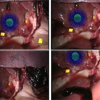MICCAI
2010
Springer
14 years 1 months ago
2010
Springer
Modeling and analyzing surgeries based on signals that are obtained automatically from the operating room (OR) is a field of recent interest. It can be valuable for analyzing and u...
IJRR
2010
14 years 1 months ago
2010
Robots consisting of several concentric, preshaped, elastic tubes can work dexterously in narrow, constrained, and/or winding spaces, as are commonly found in minimally invasive s...
ISBMS
2010
Springer
14 years 5 months ago
2010
Springer
In this paper, we present a physically-based simulation framework to build up real-time Minimally invasive surgery (MIS) simulators using pointbased techniques. In our framework, s...
VISUALIZATION
1999
IEEE
14 years 7 months ago
1999
IEEE
We present the design of a simulator for a prototype interventional magnetic resonance imaging scanner. This MRI scanner is integrated with an operating theater, enabling new tech...
MICCAI
2010
Springer
14 years 8 months ago
2010
Springer
The effectiveness and clinical benefits of image guided surgery are
well established for procedures where there is manageable tissue motion. In
minimally invasive cardiac, gastro...
WACV
2002
IEEE
14 years 8 months ago
2002
IEEE
Video-endoscopy (Figure 1), a mode of minimally invasive surgery, has proven to be significantly less invasive to the patient. However, it creates a much more complex operation env...
IS4TH
2003
Springer
14 years 8 months ago
2003
Springer
The construction of surgery simulators will be a key tool in the development and diffusion of minimally invasive surgery. Nowadays, most simulators are oriented to training surgeon...
MICCAI
2005
Springer
14 years 9 months ago
2005
Springer
Computer-based simulation is an important tool for surgical skills training and assessment. In general, the degree of realism experienced by the trainees is determined by the visua...
ICRA
2005
IEEE
14 years 9 months ago
2005
IEEE
Abstract— Minimally invasive surgery (MIS) challenges the surgeon’s skills due to his separation from the operation area which can only be reached with long instruments. To ove...
MIAR
2006
IEEE
14 years 9 months ago
2006
IEEE
Intraoperative assistance systems aim to improve the quality of the surgery and enhance the surgeon’s capabilities. Preferable would be a system which provides support depending ...


